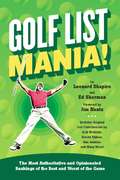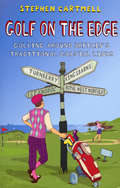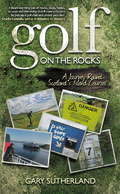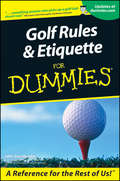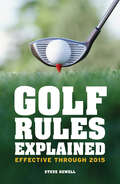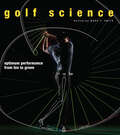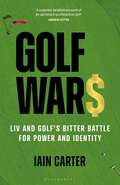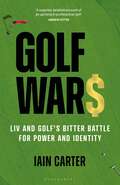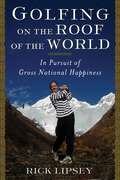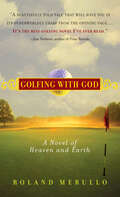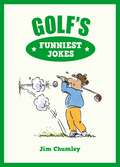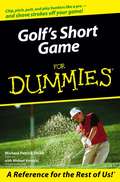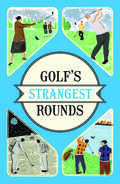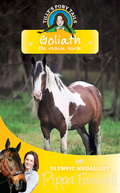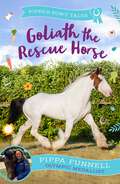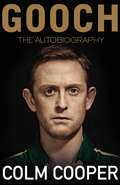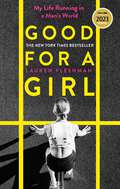- Table View
- List View
Golf List Mania!: The Most Authoritative and Opinionated Rankings of the Best and Worst of the Game
by Len Shapiro Ed ShermanFrom Best Courses to Biggest Chokes, Most Underrated to Worst-Dressed Golfers, Golf List Mania! includes 120 lists that will inform and entertain. Includes contributions by personalities including Jack Nicklaus, David Feherty, and more, plus a Foreword by Jim Nantz. Why you'll enjoy this book: 5. Contributions from famous golf writers. You'll get the perspective from some of the best in the business. 4. Lists from the greats, including golf's "Big 3": Jack Nicklaus, Arnold Palmer and Gary Player. It doesn't get much better than that. 3. A walk through golf history from Young and Old Tom Morris to Tiger Woods. You'll learn a thing or two along the way. 2. There are no right answers. The fun part of this book is the debates that they spark. I'm sure there will be lists when you go, "That guy is a complete idiot." Isn't that the essence of golf and sports? 1. The next best thing to playing golf is reading about golf. You also make fewer bogeys that way. My good friends, Ed and Len, have compiled more than 100 juicy and interesting lists that are sure to entertain. I hope you enjoy this unique look at the game we all love.
Golf On The Edge
by Stephen CartmellBecause of its island status, the British shoreline enjoys more traditional coastal golf courses than anywhere in world. When Stephen Cartmell set himself the challenge of finding and testing eighteen of the most outstanding links courses in Britain, he decided that they had to meet a number of important criteria - the most significant of which was that the sea had to be visible from the course and, preferably, should present a physical hazard to any wayward shots. Stephen Cartmell provides hilarious descriptions of these sea-flanked courses, not to mention the characters he meets on his journey around the British coastline in this perfect guide for those tempted to play Golf on the Edge.
Golf on the Rocks: A Journey Round Scotland's Island Courses
by Gary SutherlandGary Sutherland was a lapsed golfer, until he acquired his late dad's putter. After studying a crumpled golf map of Scotland, Gary decided to embark on a voyage. His target was to play 18 rounds of golf on 18 Scottish islands in honour of his dad, a ship's captain who, when he wasn't at sea, was never off the golf course. His journey would take him from the Northern Isles to the Outer Hebrides. Playing in the Harris hail and Arran sunshine, he would encounter an odd variety of golfing hazards, including sheep on the tees, cows on the fairways and electric fences round the greens. This is golf in the raw - a million miles from St Andrews. It is a life-affirming tale of remembrance and discovery. It's about having a laugh and holding on to what's dear. And it's about a putter with magical properties. You can believe what you choose to, but it all happened...
Golf Rules and Etiquette For Dummies (For Dummies Ser.)
by John SteinbrederHow to stick to the rules -- and avoid the traps of the game Filled with tips and anecdotes from the pros plus the 34 rules of golf, this ideal companion to the top-selling Golf For Dummies, 2nd Edition includes: Expert advice on the do's and don'ts of golf etiquette -- from dress code to betting on the game Advice on how to survive a business golf outing -- plus tips on behavior as both a spectator and a player The inside scoop on proper etiquette, from replacing divots to using your cell phone
Golf Rules Explained: Effective Through 2015
by Steve NewellIn golf, as in law, ignorance is no excuse. Inadvertently lifting a ball without permission, or removing a certain type of obstruction, will lead to penalty strokes and possibly mean the difference between victory and defeat. The rules of golf have been formulated to ensure orderly play, resolve disputes and answer a host of questions about various likely scenarios. Every four years R&A (the governing body for the Rules of Golf) and the United States Golf Association agree any necessary amendments or clarifications to the rules. This edition of Golf Rules Explained has been revised and updated to include all of the latest developments for the 2012-2015 period. Following an extended introduction featuring points of etiquette, equipment, useful definitions and the rules of play, Golf Rules Explained outlines the rules in an easy-to-follow, plain-language form. What is or is not permissable on the putting green? What are the rules concerning a lost ball? What constitutes an 'outside agency'? These and many more questions are answered thoroughly and comprehensively. Illustrated with over 100 colour photographs, and produced in handy-sized format, this book is your essential fairway companion.
Golf Science: Optimum Performance from Tee to Green
by Smith Mark F.Golf is perhaps the most complicated simple game ever invented. Golfing greats like Jack Nicklaus and Tiger Woods make the sport look easy, but anyone who has ever picked up a club knows how truly frustrating golf can be. The success of each shot depends on a diverse range of factors, from the club you choose and the speed with which you swing it, to your mood, the weather, and even the type and cut of the grass. Science plays a crucial role in most, if not all, of these factors, and in Golf Science, sports science expert Mark F. Smith investigates the cutting-edge scientific wonders that take the ball from tee to hole. Each chapter explores a different facet of the game—mind and body, the swing, the equipment, the environment, coaching with technology, the practice process, and the score—and is organized around a series of questions. What happens in the brain during the preshot routine? Does head movement hinder swing performance? Will I hit the ball farther with a longer driver? Why do I lose distance into the wind? What can I learn from watching my ball in flight? How should practice be structured? What are the key stats in golf that I need to know? Each question is examined with the aid of explanatory diagrams and illustrations, and the book can be used to search for particular topics, or read straight through for a comprehensive overview of how golfer and equipment work together. A must-have for anyone who delights in the spirit of the game, Golf Science will be enjoyed not only by professionals and coaches but also by spectators of the PGA Tour and anyone who enjoys a round of eighteen holes on the weekend.
Golf Science: Optimum Performance from Tee to Green
by Smith Mark F.Golf is perhaps the most complicated simple game ever invented. Golfing greats like Jack Nicklaus and Tiger Woods make the sport look easy, but anyone who has ever picked up a club knows how truly frustrating golf can be. The success of each shot depends on a diverse range of factors, from the club you choose and the speed with which you swing it, to your mood, the weather, and even the type and cut of the grass. Science plays a crucial role in most, if not all, of these factors, and in Golf Science, sports science expert Mark F. Smith investigates the cutting-edge scientific wonders that take the ball from tee to hole. Each chapter explores a different facet of the game—mind and body, the swing, the equipment, the environment, coaching with technology, the practice process, and the score—and is organized around a series of questions. What happens in the brain during the preshot routine? Does head movement hinder swing performance? Will I hit the ball farther with a longer driver? Why do I lose distance into the wind? What can I learn from watching my ball in flight? How should practice be structured? What are the key stats in golf that I need to know? Each question is examined with the aid of explanatory diagrams and illustrations, and the book can be used to search for particular topics, or read straight through for a comprehensive overview of how golfer and equipment work together. A must-have for anyone who delights in the spirit of the game, Golf Science will be enjoyed not only by professionals and coaches but also by spectators of the PGA Tour and anyone who enjoys a round of eighteen holes on the weekend.
Golf Science: Optimum Performance from Tee to Green
by Mark F. SmithGolf is perhaps the most complicated simple game ever invented. Golfing greats like Jack Nicklaus and Tiger Woods make the sport look easy, but anyone who has ever picked up a club knows how truly frustrating golf can be. The success of each shot depends on a diverse range of factors, from the club you choose and the speed with which you swing it, to your mood, the weather, and even the type and cut of the grass. Science plays a crucial role in most, if not all, of these factors, and in Golf Science, sports science expert Mark F. Smith investigates the cutting-edge scientific wonders that take the ball from tee to hole. Each chapter explores a different facet of the game—mind and body, the swing, the equipment, the environment, coaching with technology, the practice process, and the score—and is organized around a series of questions. What happens in the brain during the preshot routine? Does head movement hinder swing performance? Will I hit the ball farther with a longer driver? Why do I lose distance into the wind? What can I learn from watching my ball in flight? How should practice be structured? What are the key stats in golf that I need to know? Each question is examined with the aid of explanatory diagrams and illustrations, and the book can be used to search for particular topics, or read straight through for a comprehensive overview of how golfer and equipment work together. A must-have for anyone who delights in the spirit of the game, Golf Science will be enjoyed not only by professionals and coaches but also by spectators of the PGA Tour and anyone who enjoys a round of eighteen holes on the weekend.
Golf Science: Optimum Performance from Tee to Green
by Mark F. SmithGolf is perhaps the most complicated simple game ever invented. Golfing greats like Jack Nicklaus and Tiger Woods make the sport look easy, but anyone who has ever picked up a club knows how truly frustrating golf can be. The success of each shot depends on a diverse range of factors, from the club you choose and the speed with which you swing it, to your mood, the weather, and even the type and cut of the grass. Science plays a crucial role in most, if not all, of these factors, and in Golf Science, sports science expert Mark F. Smith investigates the cutting-edge scientific wonders that take the ball from tee to hole. Each chapter explores a different facet of the game—mind and body, the swing, the equipment, the environment, coaching with technology, the practice process, and the score—and is organized around a series of questions. What happens in the brain during the preshot routine? Does head movement hinder swing performance? Will I hit the ball farther with a longer driver? Why do I lose distance into the wind? What can I learn from watching my ball in flight? How should practice be structured? What are the key stats in golf that I need to know? Each question is examined with the aid of explanatory diagrams and illustrations, and the book can be used to search for particular topics, or read straight through for a comprehensive overview of how golfer and equipment work together. A must-have for anyone who delights in the spirit of the game, Golf Science will be enjoyed not only by professionals and coaches but also by spectators of the PGA Tour and anyone who enjoys a round of eighteen holes on the weekend.
Golf Wars: LIV and Golf's Bitter Battle for Power and Identity
by Iain Carter'If John le Carré decided to take on a golf story, this is the book he'd write.'Geoff Shackelford'A superbly detailed account of an uprising in professional golf.'Andrew CotterGolf is at war. PGA vs LIV. Establishment vs upstart.This is the compelling story of how golf was ripped apart. The battle for the future of professional golf has been blazing. The Saudi-backed organisation LIV Golf has struck at the very heart of the golfing establishment, setting up rival tournaments with enormous prize pots and pitting the game's most famous players against each other. Led by legend Greg Norman, it has enticed the likes of Sergio García, Ian Poulter, Lee Westwood and Jon Rahm, parking its tanks on the manicured greens of the traditional game. Its tagline: Golf but louder. With LIV now in its season and little sign of the struggle abating, BBC Golf Correspondent Iain Carter delivers the fascinating – and ongoing – account of a sporting upheaval.Golf Wars spotlights the key players, both on the course and in the boardroom, exploring how the PGA Tour and other traditional organisations are fighting back. Carter covers every twist and turn, hearing from influential figures including Rory McIlroy, Jay Monahan, Greg Norman, Keith Pelley and Tiger Woods.Through expert and up-to-date analysis of all sides of this bitter conflict, Carter reveals how the saga is unfolding and what it means for golf's future. Has the controversial Saudi Arabian state essentially bought the game? Is LIV just a sportwashing series of glitzy exhibition tournaments? Or is it a welcome challenge to the golfing hegemony and a long-awaited refresh of tired traditions? This epic tale of fierce internal warfare has shaken golf to its core and marks a seminal moment in sporting history.
Golf Wars: LIV and Golf's Bitter Battle for Power and Identity
by Iain Carter'If John le Carré decided to take on a golf story, this is the book he'd write.'Geoff Shackelford'A superbly detailed account of an uprising in professional golf.'Andrew CotterGolf is at war. PGA vs LIV. Establishment vs upstart.This is the compelling story of how golf was ripped apart. The battle for the future of professional golf has been blazing. The Saudi-backed organisation LIV Golf has struck at the very heart of the golfing establishment, setting up rival tournaments with enormous prize pots and pitting the game's most famous players against each other. Led by legend Greg Norman, it has enticed the likes of Sergio García, Ian Poulter, Lee Westwood and Jon Rahm, parking its tanks on the manicured greens of the traditional game. Its tagline: Golf but louder. With LIV now in its season and little sign of the struggle abating, BBC Golf Correspondent Iain Carter delivers the fascinating – and ongoing – account of a sporting upheaval.Golf Wars spotlights the key players, both on the course and in the boardroom, exploring how the PGA Tour and other traditional organisations are fighting back. Carter covers every twist and turn, hearing from influential figures including Rory McIlroy, Jay Monahan, Greg Norman, Keith Pelley and Tiger Woods.Through expert and up-to-date analysis of all sides of this bitter conflict, Carter reveals how the saga is unfolding and what it means for golf's future. Has the controversial Saudi Arabian state essentially bought the game? Is LIV just a sportwashing series of glitzy exhibition tournaments? Or is it a welcome challenge to the golfing hegemony and a long-awaited refresh of tired traditions? This epic tale of fierce internal warfare has shaken golf to its core and marks a seminal moment in sporting history.
Golfer and Equipment (large print)
by RnibThere are three images on this page: a golfer teeing off, a golf club and a golf ball with three golf club heads. There is a locator dot shown, which will be at the top left of the page when the image is the correct way up. There is a dashed line image border surrounding each image. The image of the golfer is on the left of the page. He is seen from the side standing facing to the left, with his head turned to the front so that all his facial features can be found. His head is in the top right of the image and down from this is his body on the right and his arm on the left. His hand holds the grip (handle) of the club and its shaft continues diagonally down to the head in the bottom left of the image. He is about to hit the ball, which sits on its tee (a small peg) to the left of the club's head. He is using a club called a driver or wood. It has a large, heavy head and is designed to hit the ball a great distance: sometimes as far as the hole. The golfer's legs are in the bottom right of the image. He wears a short-sleeved purple shirt and light blue shorts and shoes. The image of the golf club is in the middle of the page. It is the same driver used by the golfer to the left, shown at a larger scale. Its grip is in the top right of the image and its head in the bottom left. The golf ball and golf club heads can be found on the right of the page. The golf ball, with its characteristic dimples, is shown at actual size at the top of the image. Down the page you will find the head of another style of driver with a more rounded shape. Further down is the head of an iron, used for hitting the ball shorter distances. Each type of iron has its head set at a different angle to the shaft giving varying amounts of 'loft' or height to the ball. At the bottom of the image is a putter, used to knock the ball into the hole on the smooth turf of the green. It has a wide head with a panel of hardwood set into it. Golfers will carry a selection of clubs, each appropriate to hit the ball in a different location: the fairway, the rough, a bunker or on the green.
Golfer and Equipment (UEB contracted)
by RnibThere are three images on this page: a golfer teeing off, a golf club and a golf ball with three golf club heads. There is a locator dot shown, which will be at the top left of the page when the image is the correct way up. There is a dashed line image border surrounding each image. The image of the golfer is on the left of the page. He is seen from the side standing facing to the left, with his head turned to the front so that all his facial features can be found. His head is in the top right of the image and down from this is his body on the right and his arm on the left. His hand holds the grip (handle) of the club and its shaft continues diagonally down to the head in the bottom left of the image. He is about to hit the ball, which sits on its tee (a small peg) to the left of the club's head. He is using a club called a driver or wood. It has a large, heavy head and is designed to hit the ball a great distance: sometimes as far as the hole. The golfer's legs are in the bottom right of the image. He wears a short-sleeved purple shirt and light blue shorts and shoes. The image of the golf club is in the middle of the page. It is the same driver used by the golfer to the left, shown at a larger scale. Its grip is in the top right of the image and its head in the bottom left. The golf ball and golf club heads can be found on the right of the page. The golf ball, with its characteristic dimples, is shown at actual size at the top of the image. Down the page you will find the head of another style of driver with a more rounded shape. Further down is the head of an iron, used for hitting the ball shorter distances. Each type of iron has its head set at a different angle to the shaft giving varying amounts of 'loft' or height to the ball. At the bottom of the image is a putter, used to knock the ball into the hole on the smooth turf of the green. It has a wide head with a panel of hardwood set into it. Golfers will carry a selection of clubs, each appropriate to hit the ball in a different location: the fairway, the rough, a bunker or on the green.
Golfer and Equipment (UEB uncontracted)
by RnibThere are three images on this page: a golfer teeing off, a golf club and a golf ball with three golf club heads. There is a locator dot shown, which will be at the top left of the page when the image is the correct way up. There is a dashed line image border surrounding each image. The image of the golfer is on the left of the page. He is seen from the side standing facing to the left, with his head turned to the front so that all his facial features can be found. His head is in the top right of the image and down from this is his body on the right and his arm on the left. His hand holds the grip (handle) of the club and its shaft continues diagonally down to the head in the bottom left of the image. He is about to hit the ball, which sits on its tee (a small peg) to the left of the club's head. He is using a club called a driver or wood. It has a large, heavy head and is designed to hit the ball a great distance: sometimes as far as the hole. The golfer's legs are in the bottom right of the image. He wears a short-sleeved purple shirt and light blue shorts and shoes. The image of the golf club is in the middle of the page. It is the same driver used by the golfer to the left, shown at a larger scale. Its grip is in the top right of the image and its head in the bottom left. The golf ball and golf club heads can be found on the right of the page. The golf ball, with its characteristic dimples, is shown at actual size at the top of the image. Down the page you will find the head of another style of driver with a more rounded shape. Further down is the head of an iron, used for hitting the ball shorter distances. Each type of iron has its head set at a different angle to the shaft giving varying amounts of 'loft' or height to the ball. At the bottom of the image is a putter, used to knock the ball into the hole on the smooth turf of the green. It has a wide head with a panel of hardwood set into it. Golfers will carry a selection of clubs, each appropriate to hit the ball in a different location: the fairway, the rough, a bunker or on the green.
Golfing on the Roof of the World: In Pursuit of Gross National Happiness
by Rick LipseyRick Lipsey returned from a vacation with an unusual job offer. After playing a few rounds at Bhutan's Royal Thimphu Golf Club, one of the members asked if he'd consider becoming the kingdom's golf pro. "Sure, I'd love to move to Bhutan," Lipsey flippantly responded. Next thing you know, he, his wife, and their infant daughter are boarding a plane for this remote Himalayan country. With one foot in the ancient world and the other in the twenty-first century, Bhutan is working to successfully meld the old and the new, from subsistence farming and religious festivals to the Internet and World Wrestling Entertainment. In Golfing on the Roof of the World, Rick sets great golf travel writing against the bigger political story of Bhutan's entrance to the modern world. Not only does he teach and play golf in the shadow of the world's tallest peaks, but he also comes to understand the seismic shifts in store for the last Buddhist kingdom where peace and spiritual prosperity have abounded, and the national standard for measuring success is Gross National Happiness.
Golfing with God: A Novel of Heaven and Earth
by Roland MerulloHerman "Hank" Fins-Winston was a pro golfer destined for greatness. Now he lives in a condominium on the thirteenth fairway of one of heaven's glorious courses – a fact he finds surprising and amusing, since for one reason or another, a fair percentage of golfers never make it to paradise. Hank is having the time of his afterlife until he's summoned one idyllic morning to play a round with the Almighty. It seems that God is having some trouble with His game. As they play the heavenly courses, both in paradise and back on earth, Hank comes to realize that what began as a golf lesson has become a spiritual journey.
Golf's Funniest Jokes
by Jim ChumleyWhy did the golfer’s wife ask to be buried on the golf course? So she could be sure her husband would visit her grave. After a long day on the fairway, put away the patterned jumper and five-iron and laugh off the double-bogeys with this selection of hysterical jokes. Golf’s Funniest Jokes will suit golf fanatics to a tee.
Golf’s Greatest Collapses
by Andrew PodnieksGolf's Greatest Collapses recounts the agony-andsometimes humour-of the worst moments of agolfer's career, the moment when he can't do anythingright. Golfers collapses are borne of the weight of themoment, the gaze of thousands of fans, the click ofphotographers' cameras, the underlying awarenessthat millions of people around the world are watching.Some golfers never recover from a collapse; othersuse it to learn, and when the situation recurs, they arewiser and better able to handle the pressure of themoment. Collapses can be good in the long run, or theycan be forever devastating.
Golf's Short Game For Dummies
by Michael Patrick Shiels Michael KernickiEasy-to-grasp techniques for improving the short game About 70 percent of the shots in a round of golf are taken 75 yards from the pin or closer, making the short game the most significant factor in a golfer's score. This practical guide shows readers how to shave strokes off their game by improving their pitching, chipping, bunker play, and putting. Golfers will find expert tips on choosing the right wedges, putters, and balls, as well as illustrated step-by-step instructions on swings used in short-game shots. They'll also find information on how to beat bunkers and other hazards and how to play various lies-in deep rough, from the fairway, uphill, side-hill, and off bare ground. There's also a section on stretches, exercises, and drills to improve techniques, as well as tips on reading greens for accurate putting. Michael Patrick Sheils (Birmingham, MI) is a member of the Golf Writers Association of America. He has written four books, and his articles and columns have appeared in worldwide magazines and newspapers. Michael Kernicki (Miami Beach, FL) has been a PGA member for 27 years and is currently the Head Professional at the historic Indian Creek Country Club in Miami Beach.
Golf's Short Game For Dummies
by Michael Patrick Shiels Michael KernickiEasy-to-grasp techniques for improving the short game About 70 percent of the shots in a round of golf are taken 75 yards from the pin or closer, making the short game the most significant factor in a golfer's score. This practical guide shows readers how to shave strokes off their game by improving their pitching, chipping, bunker play, and putting. Golfers will find expert tips on choosing the right wedges, putters, and balls, as well as illustrated step-by-step instructions on swings used in short-game shots. They'll also find information on how to beat bunkers and other hazards and how to play various lies-in deep rough, from the fairway, uphill, side-hill, and off bare ground. There's also a section on stretches, exercises, and drills to improve techniques, as well as tips on reading greens for accurate putting. Michael Patrick Sheils (Birmingham, MI) is a member of the Golf Writers Association of America. He has written four books, and his articles and columns have appeared in worldwide magazines and newspapers. Michael Kernicki (Miami Beach, FL) has been a PGA member for 27 years and is currently the Head Professional at the historic Indian Creek Country Club in Miami Beach.
Golf's Strangest Rounds: Extraordinary But True Stories From Over A Century Of Golf (Strangest Ser.)
by Andrew Ward‘The most eccentric golf book ever’ Sports and Leisure Magazine
Goliath the Rescue Horse: Book 13 (Tilly's Pony Tails #13)
by Pippa FunnellMeet Tilly Redbrow, who doesn't just love horses - she lives, breathes and dreams them too! At World Horse Welfare, Tilly meets neglected shire horse Goliath, and she's determined to help him find a new home.For every girl who has ever longed for a pony of her own, these delightful, warm and engaging stories are packed with Pippa Funnell's expert advice on everything you ever wanted to know about horses.
Goliath the Rescue Horse (Pippa's Pony Tales #13)
by Pippa FunnellTilly dreams of having a pony of her own. One that only she can ride to stardom. Will her wishes come true when she joins Silver Shoe Farm Stables?Tilly learns all about World Horse Welfare and, when she visits their rehabilitation centre, she falls in love with gentle giant, Goliath, the shire horse. What can she do to help find him a new home?Collect all 18 titles in this series of irresistible, uplifting and heartwarming pony adventures. Printed in a dyslexia friendly font and packed with up to date tips from three times Olympic Medallist, Pippa Funnell, as well as a helpful glossary and black and white illustrations on every spread.
Gooch - The Autobiography
by Colm Cooper'The greatest Gaelic footballer of all time.' Pat SpillaneWhen Colm Cooper retired from inter-county football in 2017, he left behind a remarkable legacy. The holder of five All-Ireland medals and eight All-Stars, he was Kerry’s stand-out forward for fifteen years. From a family steeped in Gaelic football, and a core member of the Dr Crokes team, Colm was still in his teens when he first played for Kerry at senior level. Overcoming struggles with injury and personal tragedy, Cooper became one of the GAA’s most recognizable and best-loved figures at a time of tumultuous change in the game. But the man known nationally as ‘Gooch’ is also an intensely private figure who has never courted publicity and his personal story remains largely untold. Now Gooch – The Autobiography unlocks a previously unopened door, tracing a compelling path through the life beyond the headlines. This is the story of an ordinary man who became an extraordinary footballer.
Good for a Girl: My Life Running in a Man's World
by Lauren Fleshman'Women's sports have needed a manifesto for a long time. With Good for a Girl we finally have one' Malcolm Gladwell 'The invitation to have a long overdue conversation for a long overdue cultural shift' Alysia Montaño, Olympian, co-founder of &Mother, and author of Feel-Good Fitness 'This is the book we've been waiting for' Kate Fagan, author of What Made Maddy RunLauren Fleshman has grown up in the world of running. One of the most decorated collegiate athletes of all time and a national champion as a pro, she was a major face of women's running for Nike before leaving to shake up the industry with feminist running brand Oiselle and coach elite young female runners. Every step of the way, she has seen how our sports systems - originally designed by men, for men and boys - fail young women and girls as much as empower them. Girls drop out of sports at alarming rates once they hit puberty, and female collegiate athletes routinely fall victim to injury, eating disorders or mental health struggles as they try to force their way past a natural dip in performance for women of their age.Part memoir, part manifesto, Good for a Girl is Fleshman's story of falling in love with running as a girl, battling devastating injuries and self-doubt, and daring to fight for a better way for female athletes. Long gone are the days when women and girls felt lucky just to participate; Fleshman and women everywhere are waking up to the reality that they're running, playing and competing in a world that wasn't made for them. Drawing not only on her own story but also on emerging research on the physiology and psychology of young athletes of any gender, Fleshman gives voice to the often-silent experience of the female athlete and argues that the time has come to rebuild our systems of competitive sport with women at their centre.Written with heart and verve, Good for a Girl is a joyful love letter to the running life, a raw personal narrative of growth and change, and a vital call to reimagine sports for young women.
